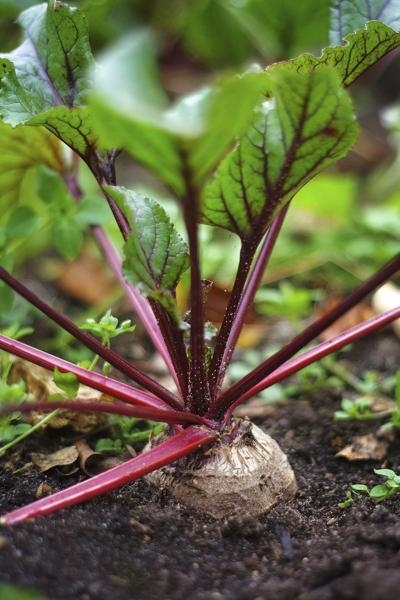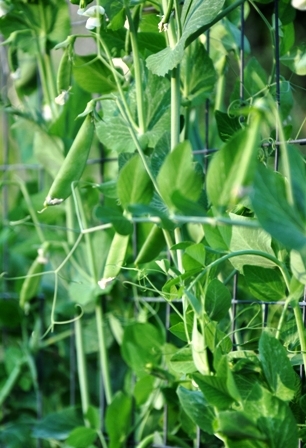Beets, Snap Peas, or Brussels Sprouts... Growing Winter Vegetables?
Advice for the Home Gardener from the Help Desk of the
UC Master Gardener Program of Contra Costa County
Client's Request: Questions about Winter Growing of Beets, Snap Peas and Brussels Sprouts
Hello! Reaching out for a little help with my fall/winter garden. I have 4 small, 4x8 beds that I started this year (raised beds, all new soil). I am having a tough time this season, so passing along a few questions if you are able to assist at all.
Beets
I planted some starters and seeds on Sept 10. They are significantly underdeveloped. After some online research, it seems I needed to thin them out, but I did. Maybe that is probably the main problem. The starters and seeds have grown leaves (albeit not large ones) but the beets are not maturing at all. My question... can I still thin them out or did I miss my window?
Snap Peas
I have about 6 Snap Pea plants that look good and were planted (from starters) in mid-Sept, but they are not producing many pea pods at all. They flower just fine and the plants look very healthy, but not much fruit production. It is likely they are not pollinating. Question... these are supposed to be self-pollinating, so can I simply “shake” them a bit to trigger pollination or is my window closed at this point in the season?
Brussels Sprouts
I also planted 6 Brussels Sprout starters in early Sept, but I was hit pretty bad with an aphid infestation which I couldn't get under control and it seems to have stunted their growth. I can see small sprouts growing on some stalks but the plants are not much more than a foot tall. The leaves look OK. Question... will these recover (should I just leave them) or are they most likely finished now that we are 3 months from planting the starters?
MGCC Help Desk Response: Thank you for contacting our UC Master Gardener Program Help Desk with questions about your winter vegetable garden. First off, good for you for growing winter vegetables. Being able to have a winter garden is one of the blessings of living in Contra Costa County. Don't be discouraged by the struggles you are encountering now. Even if you have a few disappointing results this year, we have some tips for you that may lead to better success next time.

First off, it's not too late to thin the beets, but you need to be careful about how you do the thinning. Ideally you would space each beet plant about three inches from its closest neighbor. When you thin, don't simply pull out a plant. Doing that may injure the roots of nearby plants and stunt their growth. A better way to thin is to use a small pair of scissors to cut off a plant's leaves at the ground surface which will avoid injury to nearby plants. And don't forget that the beet greens you snip off would be very tasty in a salad or sautéed in olive oil with a little garlic.
It's harder to know whether thinning now will still help. Once the weather has turned cold and even day-time temperatures are not very warm, beet growth will slow down. If the plant has not stored enough energy already to nourish the developing beet, even with thinning, you may not get large beets from this year's crop. But you don't have anything to lose by thinning and waiting a while longer to see what develops. If you don't have good sized beets when the temperatures warm next spring, don't leave the beets in the ground thinking they may grow larger. They will more likely just go to seed and die.
Here are some other tips that may increase your chances for getting good beet production in your next crop.
The timing of planting beets is one important consideration. Thinning depends upon where you are located in Contra Costa County. If you are located in the interior regions of Contra Costa County (i.e., the central or eastern regions of the County), your Sept. 10 planting date was a good time. However, if you live in the coastal regions of the county where the climate is more influenced by the San Francisco Bay or San Pablo Bay (e.g. Richmond, El Cerrito, Crockett, etc.), a Sept. 10th planting date would be a little too late. In that region, for beets planted for winter time harvest, beets are best started by late July. You can find recommended planting times for most vegetable crops on our U.C. Master Gardeners of Contra Costa Website. Here's a link that will take you to both the listings for interior regions and for coastal regions of our County: http://ccmg.ucanr.edu/EdibleGardening/VegetablesforContraCosta/ . Incidentally, as you'll see on the planting guides, you'll have another chance to plant beets early next spring (as early as February in coastal regions and in March for interior regions).
Additionally, over-crowding can certainly inhibit beet development. A better approach for avoiding over-crowding of your next beet crop would be to be more careful about spacing when you plant. For root crops like beets and carrots, it's best to start from seed since transplanting small seedlings can stress the plants. One strategy you might try for your next crop would be to use pelleted seeds. Beet seeds are quite small and when placed on the soil can be hard to see, so it's hard to get the spacing right. Pelleted seeds have been covered with a coating of inert material that is built up into pellets about the size of a sesame seed. Each pelleted sphere contains a single seed and is white in color. It's easy to plant them with the ideal 3 inch spacing between plants and you won't have to thin at all. You can find places to buy the pelleted seeds by doing an internet search for “pelleted beet seeds”.
Also, be sure to plant your beet seeds a little deeper than you would plant other vegetable seeds. Typically, seeds should be planted about two times the length of the seed. But beet seeds should be placed a little deeper—put them about ½ inch below the soil surface.

If you live in the interior regions of the County, your planting time was good. If you live in a coastal region, you may have planted earlier than needed, but since the plants are apparently growing well and blooming, that may not be an issue for this crop. (The main reason to avoid planting too early in the season is to avoid the development of powdery mildew which is typically more of a problem for developing peas in warmer fall weather than over the colder winter months.)
You are correct that snap peas are “self-pollinating” and they do not require a visit by a honey bee or other pollinating insect to form pods. In fact, peas often are pollinized even before the flower opens. Shaking them a bit may encourage the self-pollinizing.
You mentioned that you transplanted pea seedlings. Transplanting is an acceptable method of planting peas, but keep in mind that you can also plant pea seeds directly in your garden. If you are buying seedlings at a nursery, you can save some money by switching to direct seeding. The main reason for transplanting pea seedlings to the garden would be to avoid having the newly emerging seedlings attacked by snails, slugs, birds or other pests.
Our final suggestion for the peas is to be patient. I typically plant seeds in my Pleasant Hill garden in mid-September. In some years, I have a pea crop producing by now. But some years, I have to wait until early spring to start the harvest. So your plants may just need a little more time to produce.
Your Brussels Sprouts. You told us that you transplanted Brussels sprout seedlings into your garden in early September. We understand that the young seedlings were hit with a bad aphid infestation in the fall and it took you a while to get things under control. You report that you can see small sprouts growing on some stalks but the plants are not much more than a foot tall. We understand that the leaves look OK. You asked whether there is any hope at this point that you might be able to harvest some Brussels sprouts.
Based on your report, it is somewhat doubtful that you'll get to harvest well developed mature Brussels sprouts from this crop. But at this time of year, there are no other vegetables that you could be successful starting in the garden, so you might as well leave the Brussels Sprouts to grow a while longer and see what develops.
I have been growing vegetables in the Bay Area for more than twenty-five years, and I have always found Brussels Sprouts to be the most challenging crop to grow successfully. Some years I get a decent crop, but other years even when everything looks to be going well, an unusual warm spell in January or February will cause the developing sprouts to open prematurely. I always hedge my bets when I plant Brussels sprouts by planting plenty of other brassica vegetables that can fill in if the Brussels sprouts don't do well. I particularly like Romanesco which is a very reliable producer.
For your Brussels sprouts, I see two possible problems. First off, early September is a little late to get the transplants into your garden. The Brussels sprouts need to grow into fairly large plants by the time cold weather sets in. Otherwise, the plants won't have sufficient energy to nourish the developing sprouts. In years when I get a good crop, the plants are about two feet tall with large leaves before the sprouts start forming on the stalk. Next year, try to get your transplants into the ground in early August if you are using a “short season” variety that is able to mature in about 90 days. Start even earlier if you are growing a “long season” variety that could take up to 150 days to mature.
And, as you realize, the aphid infestation was definitely a problem for your Brussels Sprouts. Aphids are a common issue for all brassica plants. Typically, the aphids are most likely to be a problem in late fall or in the spring when daytime temperatures are warm but not hot (65°-80°F). When temperatures are in that range, check your plants regularly for aphids—at least twice a week—in order to catch aphid infestations early, so you can knock or hose the aphids off the plants or prune them out. You can find additional information about managing aphids at this UC website: http://ipm.ucanr.edu/PMG/PESTNOTES/pn7404.html
Hopefully this information will prove useful for increasing your winter vegetable crop success. You're welcome to contact us again if you have further questions.
Help Desk of the UC Master Gardener Program of Contra Costa County (tkl)
Note: UC Master Gardeners Program of Contra Costa's Help Desk is available almost year-round to answer your gardening questions. Except for a few holidays (e.g., last 2 weeks December), we're open every week, Monday through Thursday for walk-ins from 9:00 am to Noon at 2380 Bisso Lane, Concord, CA 94520. We can also be reached via telephone: (925) 608-6683, email: ccmg@ucanr.edu, or on the web at http://ccmg.ucanr.edu/Ask_Us/. MGCC Blogs can be found at http://ccmg.ucanr.edu/HortCoCo/ You can also subscribe to the Blog (//ucanr.edu/blogs/CCMGBlog/)